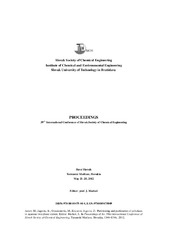Partitioning and purification of cellulases in aqueous two-phase system
Апстракт
Aqueous two-phase systems can be formed by mixing the solutions of two mutually incompatible polymers or polymer and salt above critical concentrations and represent media that are very well suited for the separation and purification of biomolecules. The basis of separation is uneven distribution of biomolecules between two phases both having high water content. This so-called biocompatibility of phases allows preservation of biomolecules’ native structure while the presence of polymer can even improve their stability. Partitioning is governed by numerous factors that can be manipulated to achieve desired separation and purification results, which makes aqueous two-phase system very flexible for application. Cellulases, enzymes belonging to family of glycosyl hydrolases, play key role in organic carbon turnover and have important and wide application in industry. Extraction of enzymes in aqueous two-phase systems has been recognized as useful technique in downstream processing for thei...r isolation and purification. In this study, partitioning of cellulases in polyethylene glycol/dextran and polyethylene glycol/salt two-phase systems was investigated with the aim to determine the most appropriate molecular weight of polymers, kind of salt and concentration of aqueous two-phase constituents at which the highest possible yield and purification factor in the top phase can be achieved.
Кључне речи:
aqueous two-phase system / cellulases / separation / purificationИзвор:
Proceedings of the 39th International Conference of Slovak Society of Chemical Engineering, 2012, 1346-1346Издавач:
- Tatranské Matliare : Slovak Society of Chemical Engineering
Институција/група
Tehnološko-metalurški fakultetTY - CONF AU - Antov, Mirjana AU - Jugović, Branimir AU - Gvozdenović, Milica AU - Knežević-Jugović, Zorica PY - 2012 UR - http://TechnoRep.tmf.bg.ac.rs/handle/123456789/2015 AB - Aqueous two-phase systems can be formed by mixing the solutions of two mutually incompatible polymers or polymer and salt above critical concentrations and represent media that are very well suited for the separation and purification of biomolecules. The basis of separation is uneven distribution of biomolecules between two phases both having high water content. This so-called biocompatibility of phases allows preservation of biomolecules’ native structure while the presence of polymer can even improve their stability. Partitioning is governed by numerous factors that can be manipulated to achieve desired separation and purification results, which makes aqueous two-phase system very flexible for application. Cellulases, enzymes belonging to family of glycosyl hydrolases, play key role in organic carbon turnover and have important and wide application in industry. Extraction of enzymes in aqueous two-phase systems has been recognized as useful technique in downstream processing for their isolation and purification. In this study, partitioning of cellulases in polyethylene glycol/dextran and polyethylene glycol/salt two-phase systems was investigated with the aim to determine the most appropriate molecular weight of polymers, kind of salt and concentration of aqueous two-phase constituents at which the highest possible yield and purification factor in the top phase can be achieved. PB - Tatranské Matliare : Slovak Society of Chemical Engineering C3 - Proceedings of the 39th International Conference of Slovak Society of Chemical Engineering T1 - Partitioning and purification of cellulases in aqueous two-phase system EP - 1346 SP - 1346 UR - https://hdl.handle.net/21.15107/rcub_technorep_2015 ER -
@conference{
author = "Antov, Mirjana and Jugović, Branimir and Gvozdenović, Milica and Knežević-Jugović, Zorica",
year = "2012",
abstract = "Aqueous two-phase systems can be formed by mixing the solutions of two mutually incompatible polymers or polymer and salt above critical concentrations and represent media that are very well suited for the separation and purification of biomolecules. The basis of separation is uneven distribution of biomolecules between two phases both having high water content. This so-called biocompatibility of phases allows preservation of biomolecules’ native structure while the presence of polymer can even improve their stability. Partitioning is governed by numerous factors that can be manipulated to achieve desired separation and purification results, which makes aqueous two-phase system very flexible for application. Cellulases, enzymes belonging to family of glycosyl hydrolases, play key role in organic carbon turnover and have important and wide application in industry. Extraction of enzymes in aqueous two-phase systems has been recognized as useful technique in downstream processing for their isolation and purification. In this study, partitioning of cellulases in polyethylene glycol/dextran and polyethylene glycol/salt two-phase systems was investigated with the aim to determine the most appropriate molecular weight of polymers, kind of salt and concentration of aqueous two-phase constituents at which the highest possible yield and purification factor in the top phase can be achieved.",
publisher = "Tatranské Matliare : Slovak Society of Chemical Engineering",
journal = "Proceedings of the 39th International Conference of Slovak Society of Chemical Engineering",
title = "Partitioning and purification of cellulases in aqueous two-phase system",
pages = "1346-1346",
url = "https://hdl.handle.net/21.15107/rcub_technorep_2015"
}
Antov, M., Jugović, B., Gvozdenović, M.,& Knežević-Jugović, Z.. (2012). Partitioning and purification of cellulases in aqueous two-phase system. in Proceedings of the 39th International Conference of Slovak Society of Chemical Engineering Tatranské Matliare : Slovak Society of Chemical Engineering., 1346-1346. https://hdl.handle.net/21.15107/rcub_technorep_2015
Antov M, Jugović B, Gvozdenović M, Knežević-Jugović Z. Partitioning and purification of cellulases in aqueous two-phase system. in Proceedings of the 39th International Conference of Slovak Society of Chemical Engineering. 2012;:1346-1346. https://hdl.handle.net/21.15107/rcub_technorep_2015 .
Antov, Mirjana, Jugović, Branimir, Gvozdenović, Milica, Knežević-Jugović, Zorica, "Partitioning and purification of cellulases in aqueous two-phase system" in Proceedings of the 39th International Conference of Slovak Society of Chemical Engineering (2012):1346-1346, https://hdl.handle.net/21.15107/rcub_technorep_2015 .



